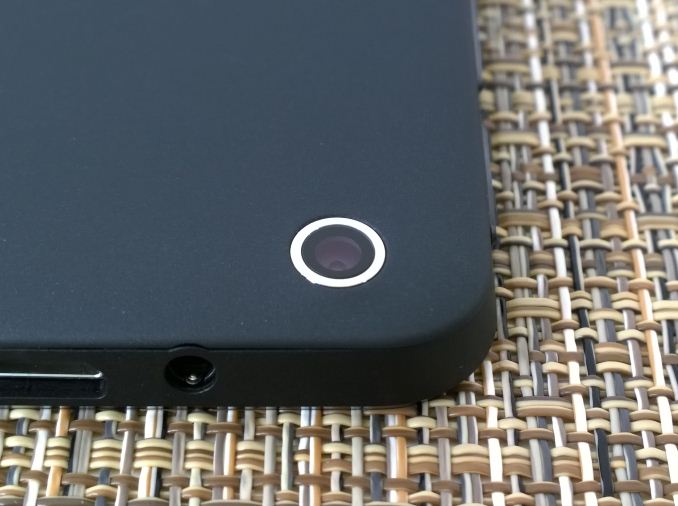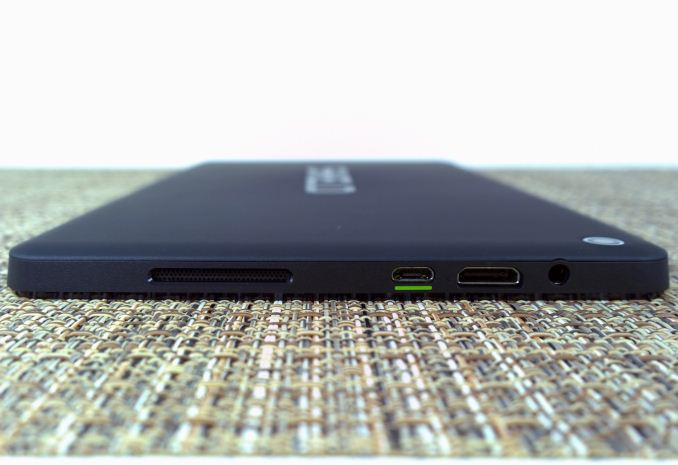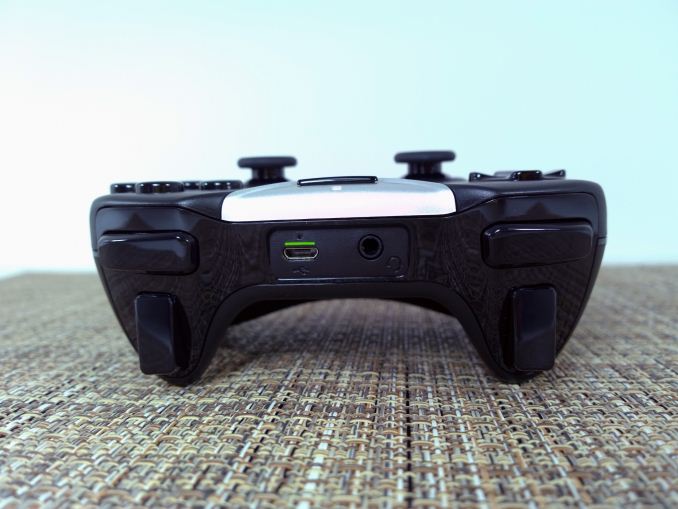The NVIDIA SHIELD Tablet Review
by Joshua Ho on July 29, 2014 9:00 AM ESTFinal Words
If I’m honest, it’s hard for me to review tablets. While I academically understand why people like tablets, I’ve never really found a use for them. They’re less comfortable to use in bed than a phone, I usually can’t type on a tablet as quickly as I do on a phone due to the size and weight, and in general it’s hard to justify a tablet when a phone is generally much more versatile. So when I got the Shield Tablet, I didn’t really know what to expect. While I have a Shield Portable, I don’t spend much time gaming on it, especially when I have a desktop that can do it much better. I came away from my experience pleasantly surprised.
Over the past five days, I’ve learned a lot about this device. As a tablet, it’s good. The material design and industrial design is acceptable and the device itself is quite ergonomic but it doesn’t blow me away. However, given the need to meet cost constraints, the matte plastic feel is really all that’s necessary and I don’t have any complaints in this area.
In the other fundamentals, we see a bit of a checkered pattern. In the display, the static contrast is quite high, and the calibration is good, but the gamut of the display doesn’t cover sRGB. This would definitely be an area that should be improved for the next generation. Although there are some compelling reasons to go with smaller color gamut, it ends up as a disadvantage when compared to other general-purpose tablets. The display is still perfectly usable, but it's a bit more washed out than I'd like.
In battery life, we see that the Shield Tablet ends up doing relatively well in web browsing, but for intensive gaming the tablet can’t spend much time away from an outlet before draining the battery completely. This is likely to be an unavoidable tradeoff, given the immense amounts of performance that Tegra K1 provides versus the power costs of doing so on a 28nm process. Anyone that has lived with a gaming laptop should understand this. As said before, it’s also possible to improve battery life from the 2.5 hour figure if the game is light enough to allow the GPU to run at lower frequencies. Barring that, NVIDIA has included options to cap the maximum frame rate of the display and reduce maximum CPU frequencies.
Otherwise the only other notable difficulty I’ve run into is with the stylus. Generally speaking it works well enough, but the stylus requires a bit more lift between words than I’m used to and keeping it from feeling fully natural. But I will be the first to admit that this is a minor issue at best.
Outside of the tablet itself, the gaming features are compelling. The larger 8” display and massively improved SoC on the Shield Tablet made for a far better gaming experience than what I had on Shield Portable. There’s a great deal of potential in ShadowPlay on a tablet, as while screen recording is nothing new in PCs this feature is often difficult to enable on Android. This is before we talk about the effects that live video encoding has on UI performance. ShadowPlay has managed to enable easy screen recording on a mobile device and do so without significantly impacting performance.
Meanwhile GameStream and GRID are even better on the larger screen that the tablet provides. While it was cool to play PC games on the Shield Portable, the size of the display simply made some elements too small to reasonably see. Now, there are no such issues. GameStream and GRID are definitely a lot of fun to use, especially if the game is well-adapted to playing on a controller.
Ultimately though, I feel that the native game library is the most important aspect of this device. While there are plenty of solid single player games, multiplayer games are few and far between. I still feel that multiplayer is where Shield has the strongest potential because it makes the difference between tens of hours per game and hundreds, even thousands of hours per game. There are definitely signs that this aspect of the ecosystem will improve in the near future as Trine 2 supports local multiplayer and War Thunder on Shield Tablet should be able to play online against console and PC players.
After getting through all of these observations over the past five days, I’ve come to realize that even though it’s not the perfect tablet, all of the features that this device brings to the table right now would be enough for me to seriously consider buying one. If NVIDIA manages to get enough multiplayer titles with an active community on Shield Tablet, there wouldn’t be a need to stop and consider at all. As someone that has spent the past few years never considering a tablet purchase at all, the Shield Tablet is the first ARM tablet that I would seriously think about buying.
The SHIELD Tablet is 299 USD for the 16GB WiFi model, 399 USD for the 32 GB LTE model. Each controller is 59.99 USD and the cover is 39.99 USD. While the 16GB model is 70 dollars more expensive than the Nexus 7 equivalent, the gap narrows to 50 dollars for the 32GB LTE model. Given the sheer amount of utility that this device brings to the table, the pricing is definitely set at the right place.














174 Comments
View All Comments
ams23 - Tuesday, July 29, 2014 - link
Oh and by the way, Shield tablet has a native resolution of 1920x1200. The 1080p offscreen tests in GFXBench are done at a resolution of 1920x1080. They are not the same thing! Shield tablet native resolution is higher than the 1080p offscreen resolution, and that is why fps is always a bit lower onscreen vs. offscreen.lucam - Wednesday, July 30, 2014 - link
I almost agree with you. Nevertheless it's worth saying this is the first Nvidia SOC with so fast GPU. Having this sort of performance might have a drastic trade off on power consumption. I think if the A8 will have similar performance of K1 and better energy saving then yes. I doubt, by the way, the A8 will have better performance. In this round Nvidia has made better GPU performance. Question would be...isn't enough to sell enough tablets?UpSpin - Friday, August 1, 2014 - link
Nice how you throw around you with meaningless numbers. Let's get your nonsense right:Performance:
I use this benchmark comparison as base:
http://gfxbench.com/compare.jsp?benchmark=gfx30&am...
The iPad Air has a 30WHr battery, got released on November 1, 2013 and costs $500.
The NVidia Shield tablet a 20WHr battery, got released now and costs $300.
The iPad Air has in the GFX battery rundown a power consumption of 5.4WHr.
The NVidia Shield tablet hasin the GFX battery rundown a power consumption of 9.38WHr.
The iPad Air vs. the NVidia Shiled tablet has an average frame rate of
Manhatten: 12.7 FPS vs 31 FPS -> 2.44x
T-Rex: 26.2 FPS vs 65 FPS -> 2.48x
Long Term: 21.3 FPS vs 56.3 FPS -> 2.65x
Now let's put all the things together, considering the higher performance of the Tegra K1, together with the higher power consumption but also higher battery capacity of the iPad Air and we get:
The Shield Tablet consumes 1.73 times the power of the iPad Air, but performs 2.65 times faster.
If Apple clocks the A7 higher, so it consumes the same power the Tegra K1 does, the Tegra would be 1.53 times faster. Now add the fact that the Tegra K1 supports Full Open GL 4.4 and one should see, the GPU of Tegra K1 is a monstrosity. Not so the outdated A15 CPU, but for this they will release the 64bit version soon, which will fix this limiting factor.
Efficiency:
Web browsing: 10hr vs. 10.8hr -> iPad: 3Whr vs. Nvidia: 1.85Whr
Conclusion:
The Tegra K1 is faster and more efficient.
Guspaz - Tuesday, July 29, 2014 - link
The GPU is definitely fast, but how power efficient is it? If they've made a GPU that produces 2x the performance at 3x the power draw, then that's not going to be terribly competitive.Are there any tests that could validate this? Something like a GPU benchmark performed at a fixed framerate with the screen off?
ams23 - Tuesday, July 29, 2014 - link
One would have to measure at the voltage rails (which is what NVIDIA did when comparing TK1 to S800 and A7).grahaman27 - Tuesday, July 29, 2014 - link
Its definitely more efficient. Nvidia claims its 1.4x as efficient.melgross - Tuesday, July 29, 2014 - link
Over the years, Nvidia has made a lot of claims that have turned out to not be true. I'd like to see the measurements.FriendlyUser - Tuesday, July 29, 2014 - link
The technology is cool and it really looks like a premium product, something relatively rare in the android space. However, I'm still looking for a use case. I mean, why would I stream from a PC instead of playing on the PC, if it is in the vicinity? And why would anyone pay serious money for gaming on the go instead of just using a smartphone for the few moments were mobile gaming might be interesting. And, if someone really needs to game on the go, 2.5h seems too few...Anyway, the technology is really nice and the execution is quite good. If I were in the market for a tablet I would think about it. Not tempted to upgrade, though.
SpartyOn - Tuesday, July 29, 2014 - link
I have a 1st gen Shield and it's for people like me: someone who sits at a desk all day and when he comes home doesn't want to sit at another desk or use a mouse anymore. I used to hook my mITX PC up to the HDTV and play with a controller, but then when I wanted to play an RTS or an MMO, I would move it back to my study. That's just cumbersome and requires a ton of wires in both locations.With the Shield, I can carry it around easily as a handheld and hook it up to my TV in Console Mode to get 1080p game streaming - all while now leaving my PC in the study for good. A couple other great use cases: playing PC games in bed while still being able to chill with my wife, outside enjoying fresh air, sitting on the toilet, and I've even sat on a lounger in the middle of my pool and streamed games.
If playing PC games in the middle of a pool surrounded by sunshine doesn't sound boss, then I don't know what is.
FriendlyUser - Tuesday, July 29, 2014 - link
Yeah, admittedly playing in a pool does sound cool. You do have a point there. My major obstacle would be paying for the pool, I guess...